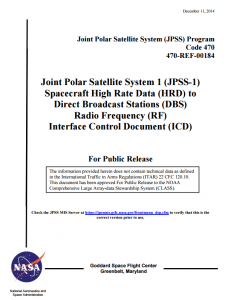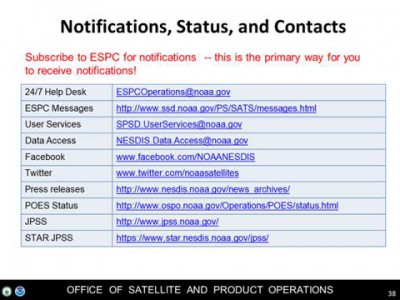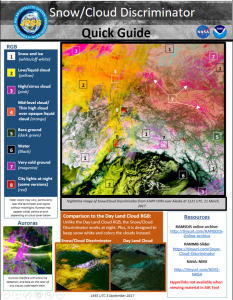The Joint Polar Satellite System (JPSS) is the Nation’s new generation polar-orbiting operational environmental satellite system. JPSS is a collaborative program between the National Oceanic and Atmospheric Administration (NOAA) and its acquisition agent, National Aeronautics and Space Administration (NASA). This interagency effort is the latest generation of U.S. polar-orbiting, non-geosynchronous environmental satellites. NOAA, an agency within the Department of Commerce (DOC), works in partnership with NASA on all JPSS missions to ensure a more “Weather-Ready Nation.”
JPSS satellites increase the timeliness and accuracy of forecasts three- to seven- days in advance of a severe weather event. NOAA’s National Weather Service uses JPSS data as critical input for numerical forecast models, providing the basis for these mid-range forecasts. These forecasts allow for early warnings and enable emergency managers to make timely decisions to protect American lives and property, including ordering effective evacuations. In addition to a more “Weather-Ready Nation,” information from JPSS supports NOAA’s missions to ensure healthy coasts, resilient coastal communities and adapt and mitigate climate change. As the Nation’s polar-orbiting satellite fleet, JPSS also enables scientists and forecasters to monitor and predict weather patterns with greater accuracy and to study long-term climate trends by extending the more than 30-year satellite data record.
JPSS satellites also provide support for zero to three day operational forecasting, which is particularly important in Polar Regions where other observational data are sparse. In Alaska, JPSS provides critical data for nearly all of the weather forecasting for aviation, as well as for the economically vital maritime, oil and gas industries.
JPSS satellites circle the Earth from pole-to-pole and cross the equator 14 times daily in the afternoon orbit—providing full global coverage twice a day. Satellites in the JPSS constellation gather global measurements of atmospheric, terrestrial and oceanic conditions—including atmospheric temperature, atmospheric moisture, hurricane intensity, clouds, rainfall, dense fog, volcanic ash, fire locations, smoke plumes, sea and land surface temperatures, vegetation, snow and ice cover and ozone.
JPSS includes four polar-orbiting satellites and a versatile ground system. These satellites, NOAA-20 (formerly JPSS-1), JPSS-2, JPSS-3 and JPSS-4 capitalize on the success of their predecessor, the Suomi National Polar-orbiting Partnership (Suomi NPP) satellite, and feature similar instruments. The ground segment system also supports satellite missions operated by partner organizations including the Department of Defense, the European Organization for the Exploitation of Meteorological Satellites and the Japan Aerospace Exploration Agency.
The state-of-the-art instruments currently flying on board the Suomi NPP satellite are the Advanced Technology Microwave Sounder (ATMS), Cross-track Infrared Sounder (CrIS), Visible Infrared Imaging Radiometer Suite (VIIRS), Ozone Mapping and Profiler Suite (OMPS) and Clouds and the Earth’s Radiant Energy System (CERES). NOAA-20 was launched on November 18, 2017 and joined the Suomi NPP satellite in the same orbit, but operates 50 minutes ahead of it, allowing for important overlap in observational data. JPSS-2 is planned for launch in 2021 and JPSS-3 and 4 missions have anticipated launch dates of 2026 and 2031 respectively.
JPSS represents significant technological and scientific advancements in observations used for severe weather prediction and environmental monitoring.








To leave a comment, please go to the posting details.